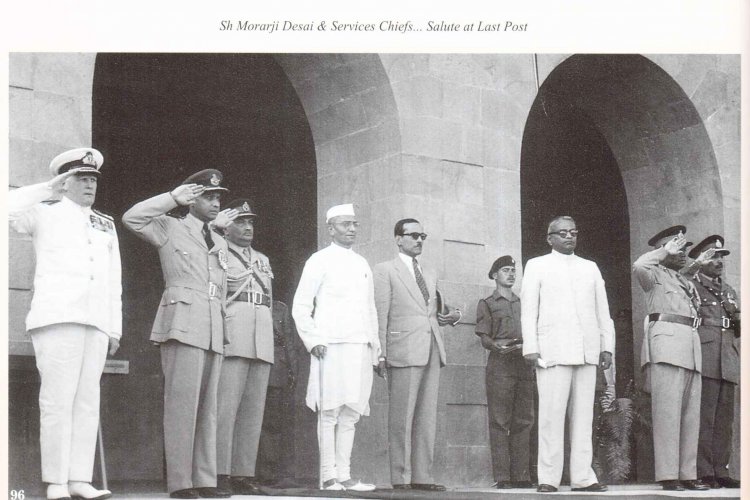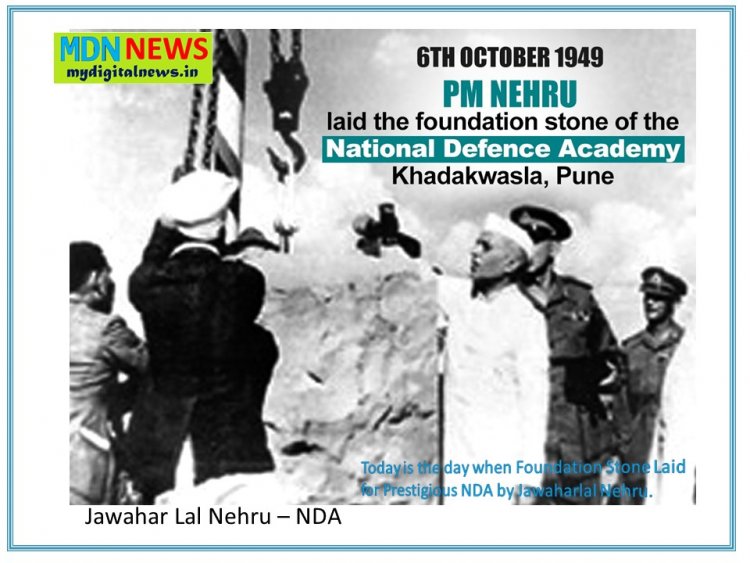Here's What No One Tells You About Great History Of NDA India
Ironically, the NDA had originated from the ancient Camp of Drona (of the Mahabharata fame) and migrated to Shivaji's seat of the Indian Military Revival that had occurred near Pune. The standards of planning and execution of Operation Badli can be gauged from the amazing fact that the total damage incurred was 'Rupees five only'!!.

At the end of World War II, Field Marshal Claude Auchinleck, then Commander-in-Chief of the Indian Army, drawing on experiences of the army during the war, led a committee around the world and submitted a report to the Government of India in December 1946.
Also Read:-
Why Campus Of NDA India Had Been So Popular Till Now?
Today is the day when Foundation Stone Laid for Prestigious NDA by Jawaharlal Nehru.
Here's What No One Tells You About Great History Of NDA India
The committee recommended the establishment of a Joint Services Military Academy, with training modelled on the United States Military Academy at West Point. After the independence of India in August 1947, the Chiefs of Staff Committee immediately implemented the recommendations of the Auchinleck report.
The committee initiated an action plan in late 1947 to commission a permanent defence academy and began the search for a suitable site.
It also decided to set up an interim training academy, known as the Joint Services Wing (JSW), which was commissioned on 1 January 1949 at the Armed Forces Academy (now known as the Indian Military Academy) in Dehradun.
Initially, after two years of training at the JSW, Army cadets went on to the Military Wing of the Armed Forces Academy for two years of further pre-commission training, while the Navy and Air Force cadets were sent to Britannia Royal Naval College Dartmouth and Royal Air Force College Cranwell in the United Kingdom for further training.
In 1941, Lord Linlithgow, the then Viceroy of India, received a gift of £100,000 from a grateful Sudanese Government towards building a war memorial in recognition of the sacrifices of Indian troops in the liberation of Sudan in the East African campaign during World War II.
Following the partition, India's share amounted to £70,000 (Rs 14 Lakh at the time; the remaining £30,000 went to Pakistan).
The Indian Army decided to use these funds to partly cover the cost of construction of the NDA. The foundation stone for the academy was laid by then Prime Minister of India, Jawaharlal Nehru on 6 October 1949. Construction started in October 1949. The revised estimated cost for the whole project was Rs 6.45 crores respectively.
The National Defence Academy was formally commissioned on 7 December 1954, with an inauguration ceremony held on 16 January 1955. The 10th JSW program was transferred from Clement Town, Dehradun to NDA Khadakwasla. It is the first tri-service academy in the world.
National Defence Academy (NDA) is an Iconic Institution and a global brand of excellence in the sphere of military education. Over the years, it has emerged as a unique military academy, attracting the best of youth from our nation and friendly foreign countries and transforming them into gentlemen officers.
During the last seven decades of its glorious existence, National Defence Academy has grown both in grace and grandeur and from its portals have emerged 'The Leaders of the men', who have demonstrated the essence of inter-services camaraderie and joint manship, thereby vindicating the faith and vision of its founding fathers.
The alumni have proved to be great mountaineers, cosmonauts, sportsmen, researchers, creative writers, artists and more recently, Olympic champions. Their achievements are all-pervading and showcased in every echelon of our Armed Forces and also in civil society. The 'cradle' has indeed rocked the nascent youth and groomed them properly as 'leaders' who have lived up to its ethos:
Seva Paramo Dharma (Service Before Self)
What is The Concept of NDA India
The concept of the NDA was conceived at the conclusion of the Second World war. Six years of fierce combat had emphatically underlined the need for 'Jointness' in modern warfare. It was believed then and correctly so that it is the primary element of synergy that provides the significant asymmetric edge in a conflict situation. At the time of its inception, the concept of NDA is unique and pioneering that was far ahead of its time. In fact, so exciting and novel was the concept that many nations looked at it with avid interest to see how it would shape out in practice.
The Government of Sudan in 1941 had given a generous gift of a hundred thousand pounds to Lord Linlithgow, the Viceroy of India, to build a war memorial to commemorate the sacrifices of the Indian troops in the Second World War for the liberation of Sudan. It was this core corpus that was later utilised to build the Sudan Block, the grand edifice of the National Defence Academy.
On 02 May 1945, a Committee was formed under the Chairmanship of the Commander-in-Chief, India, Field Marshal Sir Claude J Auchinleck, GCB, GCIE, DSO, OBE, popularly known as 'Auk', to examine the feasibility of forming an institution with excellent facilities for training the officers of the Armed Forces jointly. Many foreign training academies were visited to analyse the efficacy of their work and evolve a suitable concept for an Indian War Academy.
The Committee
The committee consisted of the following members:-
- The Chief of the General Staff.
- The Officers Commanding, Royal Indian Navy.
- The Air Officers Commanding, Royal Indian Air Force.
- Secretary to the Government of India, War Department.
- The Educational Advisor to the Government of India.
- Sir Mirza Mohammed Ismail, Prime Minister, Jaipur State.
- Rao Bahadur Rao Raja Narpat Singh, Jodhpur.
- Dr Amarnath Jha, Vice-Chancellor, Allahabad University *.
- Khan Bahadur Mian Afzal Hussian, former Vice-Chancellor of Punjab University.
- WX Mascarenhas, Principal, College of Engineering, Poona.
- AE Foot, Headmaster, Doon School, Dehradun.
- * Dr Amarnath Jha was appointed Vice Chairman of the committee that worked on the project for 16 months from 23 July 1945 to 12 November 1946.
'Auk' ceased to be the Commander-in-Chief of the undivided Indian Armed Forces on 15 August 1947, and the blueprint of the unique Academy envisaged by him remained in cold storage for about eight months. But the enthusiasm it had generated and the alarming vacuum in the officer cadre did not allow it to be shelved. In fact, its birth became a paramount necessity.
The report was finally referred to the Chiefs of Staff Committee in 1947. Their suggestion for the formation of an Interim Joint Inter-Services Wing at the Indian Military Academy, Dehradun, was accepted for implementation. Concurrently an action plan to commission a permanent war academy at Khadakwasla(Pune) was commenced and Prime Minister Pandit Jawaharlal Nehru himself laid the foundation stone on 06 Oct 1949.

“A Moment in the Making” Pt. Nehru laying the foundation stone at Khadakwasala: 6th Oct 1949
The central facade of the Academy is a true Joint Service design. The majestic Sudan Block resembles a field gun of the Army. On the right, the Vyas Library and the Naval Training Team resemble an anchor. On the left, the Habibullah Hall appears like an aircraft.
Inauguration
On 1 January 1949, the Armed Forces Academy having its military Academy and the Indian Military Academy and the Joint Services Wing were commissioned. After two years of training at JSW, the Army cadets went on to the Military wing for a further two years of pre-commission training. The Naval and the Air force cadets were sent to Dartmouth and Cranwell in the UK for advanced training. On 07 December 1954, the interim process crystallized with the commissioning of the National Defence Academy (NDA) and the Academy was formally inaugurated on 16 January 1955.
Why National Defence Academy is located in Khadakwasla?
National Defence Academy is located southwest of Pune city and northwest of Khadakwasla Lake on 7015 acres of land, Out of the 8022 acres donated by the Government of the erstwhile Bombay state. The other suggested sites were Bombay (particularly Marve), Bangalore, Dehradun, Belgaum, Deolali (Nashik), Puri, Secunderabad and Vizag.
Pune was ultimately chosen after careful deliberation for its salubrious climatic conditions, suitability of terrain for military training, proximity to the Arabian sea. The operational existence of a combined training centre and the 'mock' landing ship, HMS Angostura, on the north bank of the Khadakwasla Lake, lent additional leverage to the claims of Khadakwasla over other contenders for being chosen as the site for the prestigious NDA, with the daunting Sinhagad Fort as a panoramic backdrop.
What is Operation Badli?
Operation 'Badli' was the code name given to the great migration from Dehradun to Khadakwasla, Pune. The word ‘Dehradun’ comes from the etymological root of "Dera-Drona" or the 'Camp of Drona'. The shifting of the epicentre of this Academy from the historic Camp of Drona to Khadkwasla was not without its symbolism in military historical terms. Khadakwasla is nestled at the foot of the Sahyadri Ranges in the Western watershed of the Mula river Valley.
Operation Badli in Progress?
It is located 12 miles from Pune (former Poona of the Raj days)- the 200-year-old administrative seat of the Peshwas. The Khadakwasla complex is dominated by the looming blue skyline of the Sinhgarh Fort.
It looms over the Academy like a colossus, an overpowering iconic presence. It is a peak with a personality.
Situated atop this blue massif is the famous Sinhgarh fort which Tanaji Mlusare, the favourite General of Shivaji, had captured from the Moghuls in a daring and incredible assault up a cliff face.
Ironically, the NDA had originated from the ancient Camp of Drona (of the Mahabharata fame) and migrated to Shivaji's seat of the Indian Military Revival that had occurred near Pune. The standards of planning and execution of Operation Badli can be gauged from the amazing fact that the total damage incurred was 'Rupees five only'!!.
Note: please Comment Here for UPDATES and CORRECTIONS
Donate. Buy Us Coffee
Why news media is in crisis & How you can fix it.
India needs free, fair, non-hyphenated and questioning journalism even more as it faces multiple crises. But the news media is in a crisis of its own. There have been brutal layoffs and pay cuts. The best of journalism is shrinking, yielding to the crude prime-time spectacle. My digital news .in has very few young reporters, columnists and editors working for it. Sustaining journalism of this quality needs smart and thinking people like you to pay for it. Whether you live in India or overseas, you can do it here
Donate. https://mydigitalnews.in/donate
NOTE: Please email us for updates and corrections, if you wish to publish articles like this you can send them to info@mydigitalnews.in or mydigitalnews.in@gmail.com or you can Directicle write Articles on our Site by registering https://mydigitalnews.in/register
Disclaimer: Mydigitalnews.in provides the content from various information sources ‘as is and the content to be used only for informational purposes and not responsible for the inaccuracy or deficiency of the provided information. Mydigitalnews. in have the right, at its sole discretion, to make modifications in any aspect of the provided information.
Mydigitalnews. in Internet site may contain links to other Internet sites. While we try to link only to sites that share our high standards and respect for privacy, we are not responsible for the content or the privacy practices employed by other sites.
What's Your Reaction?










































































